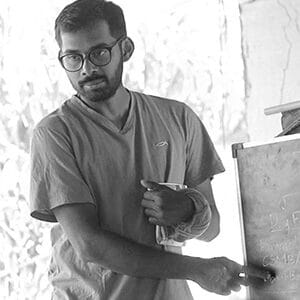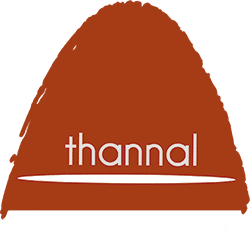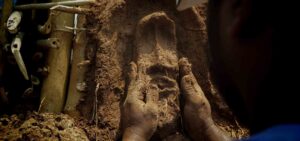We as an awareness group have always tried to follow the path of ‘Nishkama Karma’. As followers of Ramana Maharshi, our founders have been keen on practising these values in Thannal. So we try to avoid unwanted meetings, conferences or public talks. We choose not to follow these active modes of spreading awareness, but silently through our practice, workshops, publications and online learning courses to the people who reach us seeking to explore methods of shelter building close to nature
- Why are pure natural buildings the need of the hour today?
If we take a pause and inspect what is happening in the ‘sustainable architecture’ front of India, you can evidently see manipulation of Mud with cement and portraying it as the most sustainable option. But if we look into the properties of mud after mixing with cement you will be horrified to find how a fertile, soft, porous material is changed into stiff, rigid and impermeable ‘cemented’ material, like any other in the industry. Mud has a ‘breathing quality’ when used in pure form or mixed with lime, which adjusts itself to the temperature outside, like how water is kept cool in a pot. Adding cement to mud changes this property and it becomes rigid, even if it’s just 5%. As India is waking into a realisation of the need for pure organic farming & food, free from chemicals, alternate education free allowing flexibility as per individual preferences, buildings also needs to suit the local climate and be flexible enough to handle the climate change. Going local and building with available materials, especially mud (any mud available) is the right solution we believe. Hence Natural Buildings based on Indigenous techniques of India is needed. - When did you build your own home? Can you describe the process and the materials used?
Two years back. We have used a different technique with Mud, using Earth-Bags. Earth bag is a technique used by Armed forces in making outposts, comparatively fast and strong. It is also used in creating bunds and terraces to reduce soil erosion. This can also demonstrate to the locals a new technique, as Cob and Wattle and Daub were already familiar to them. Earth is filled in jute bags and used as building blocks. It was done in forty-five days, involving six farmers and two shepherds. The natural materials used were mud, lime, different plant and animal derivatives as admixtures. It’s an example of top to bottom use of Natural materials. See more photos of our earthbag home here. - What was the idea behind starting Thannal?
India has a very diverse history in indigenous Natural building techniques, but, today if we seek to learn about such methods, very few organizations are practising pure natural techniques. Out of them, no place is adequately functioning providing justice to the various existing indigenous methods. So Thannal exists to create a platform where interested people can have opportunities to learn such different languages in natural buildings. - In your experience, is the concept of hand-sculpted homes becoming popular among the urban population?
Yes, very much. It is popular among many urbanists, who are looking forward to a reverse migration eventually from the cities to the villages. Many from Bangalore and Chennai, where still low rise development is happening, find Natural Building suitable for homes in cities themselves. We truly believe wattle & daub, a technique of weaving walls and applying mud over it will be most suitable in Urban scenarios. It uses less material and can deliver thin walls, which are supported by columns. - Can you validate this with the percentage of urbanites who attended your workshops?
More than 60% of our participants are from cities. - Can you share the profiles and age groups of the people who participated?
We have people from all walks of life coming to workshops to learn more about natural buildings. Writers, fire-fighters, sculptors, government servants, farmers, school teachers, housewives and the list goes on, apart from people involved in construction as well as students of various disciplines. We have children as young as 3 years coming along with their parents to sense mud at a young age as well as, parents after retirement coming to us with children to build a natural home for themselves like older days.
Kindly check this link for a better idea.
Do you want to study Natural Building Online ?
Carry the world of learning about Indian Natural Building in your pocket, accessible from anywhere around the world.
- Which cities did they come from, professional backgrounds, etc.?
Since the time you began, how many workshops have you held – what have they covered?
We have held more than 50 workshops in different cities, on various topics in natural buildings. Our last workshop was held in Sardarshaher in Rajasthan, where local artisans were teaching about Thappi Araish Plaster, which is almost faded out of the town. This was our first Revival Workshop on a particular craft skill belonging to a place.
Workshops cover the basics of natural building techniques, enough to start a journey by themselves in the subject. Few are advanced courses on a particular technique, like the one in Sardarshaher, we also had a workshop dedicated to natural plasters only (see video here). - What are the materials typically used in a natural home?
We use generally five materials – Mud, Terracotta (baked mud), Lime, Stone, Plant and Animal
derivatives. - How much time does it take to build one?
Two to five months for a 500-600 sq. ft. home for a family. It is almost like farming; preparation is more important than building. So procurement of all required materials in the right way, treatment and preparation of admixtures is also very important. These are the major factors that contribute to the life of a natural building and must not be taken casually. It is always better to use the locally available materials as they are suited for the climate and less energy is consumed in preparing them as compared to manufactured materials. - How much money does it take to build a hand-sculpted home? Is it more cost-effective than the cement one? In what way?
We have been able to attain a construction cost of Rs. 800/- to Rs. 1000/- per sq. ft. depending on availability of materials locally. It is very affordable as compared to conventional building costs or so-called sustainable architecture, which is even expensive than the conventional architecture (Rs.2500/- to Rs. 3000/- per sq. ft.)
This is achieved as the main material required is Mud, which can be sourced from the site itself or nearby. Lime is the major binding material and is required in less quantity than cement. We do not use sand in our construction and likewise, materials that are in high demand by the construction industry are not used, which also helps in keeping our material costs down. But we refrain from using plastic wastes in our buildings as we believe the aura and positive energy in making a space more habitable are derived from natural materials only. - While such homes would find a space in rural or urban areas, how can one adapt this practice in a metro?
As mentioned, we have done a project in Nelamangala Bangalore (see photos here), where low rise development is still seen. Many have started with their own owner’s build after attending our workshops. We are yet to do a multi-storey home but one of our workshop attendees have started with one. It is possible practically to have multiple storey homes with wattle & daub technique, explained in our online publication ‘weaving walls’. We have few architects who have worked in the field of sustainable architecture with masters like Laurie Baker, completely changing into Natural Buildings. We believe is growing more villages that are self-sufficient than overcrowding the cities and increasing the demand for resources. Yet we are happy to find our workshop participants happily trying to put some of these ideas in big cities like Bangalore and Chennai, and finding the difference of shifting into natural homes. - Any cases/individuals who have done it?
Inn for Natural Hygiene, Vadakara, Kerala is an upcoming two-storey Cob Home. We are yet to portray others. - Can you share three to four ways in which one can hand sculpt a part/if not the whole of the house in a city?
People can start with say small spaces or an extension of their current homes in Natural Building techniques. They can also use Natural Plasters and Finishes on their current homes and feel how the spaces changes. One can always start with a small step but sticking to the principles of refraining from using manufactured and toxic materials, the essence of the natural building can always be achieved.
Presently mud is used as an in-fill material below flooring in all buildings in the city and manufactured materials like cement (which radiate heat and leaves a huge carbon footprint) or bricks made of by-products and industrial wastes, often toxic with chemicals are used for walls, which are coated again with harmful paints. Like this, we ourselves are creating very unhealthy and sick living spaces for ourselves. This has to change and natural materials must be used in making our spaces more livable and climate-friendly.
Thannal is not a construction group, but an awareness group that focuses on research and documentation and tries to create a platform that will help people learn about natural buildings. We only take up two projects a year, value-based, majorly in rural areas, which are done in a gift culture. Volunteering opportunities are also part of such projects to facilitate long term learning. As many of the indigenous techniques are fading and artisans who know them are in their 70s, we are trying to revive such techniques through documentation and using them in our projects. This can help us conserve these techniques and make them available for future generations. We have respected an artisan series where we invite an experienced artisan to work with us for a period of six months or a year and then learn from him. These learnings would be passed on in the revival workshop and hence conserving it from dying off. Our first successful revival workshop is completed and a platform where artisans can teach people who want to learn is created. Now Thannal will move on to a newer subject and like-wise we hope to learn more and help people learn more.
Such an initiative can help in creating more workers as well as making people aware of beautiful techniques in Natural buildings and bringing them back to the present scenario of house building.

Akhil Shajan
This article is by Natural builder Akhil Shajan. This post is part of our Thannal News series.









